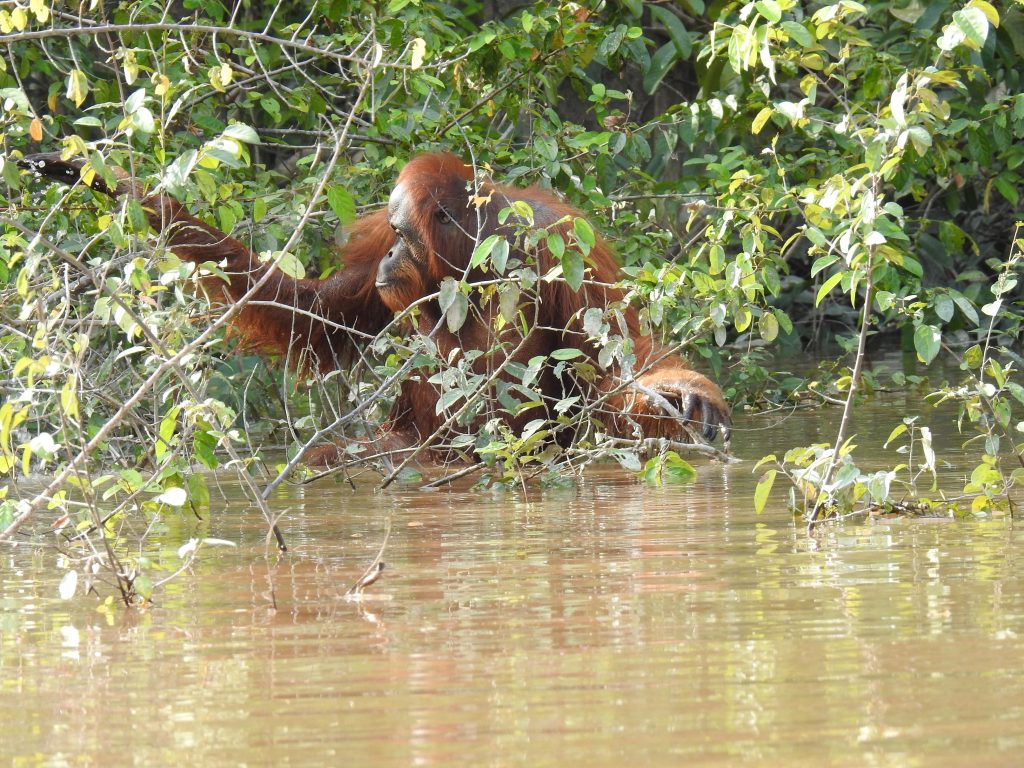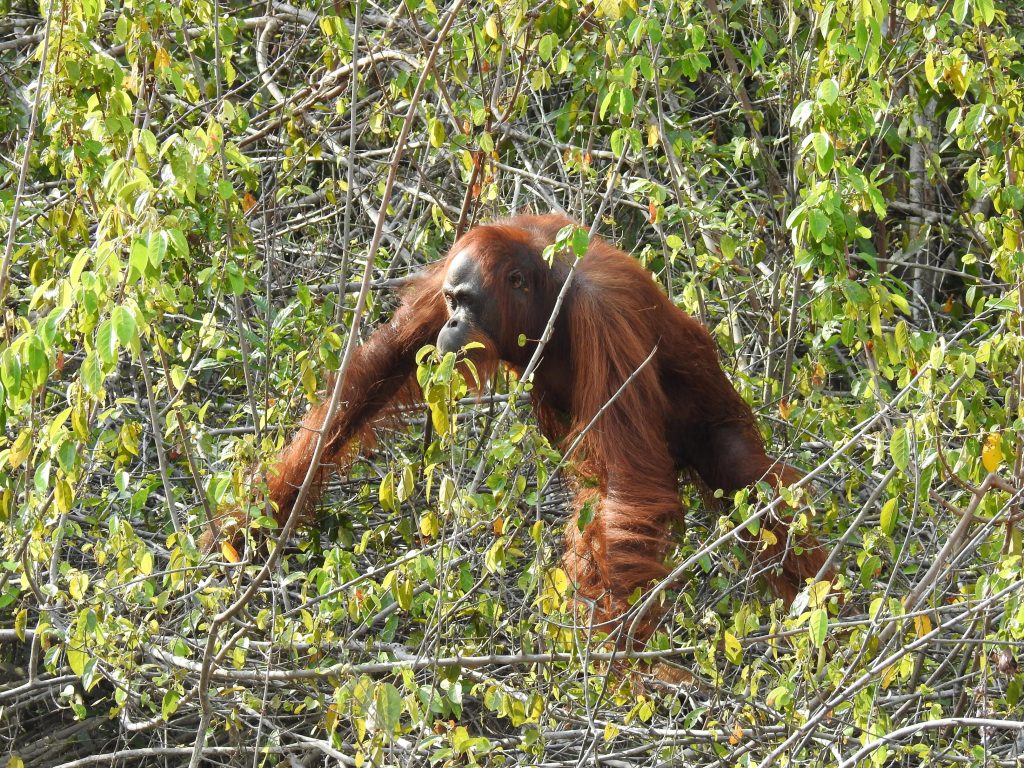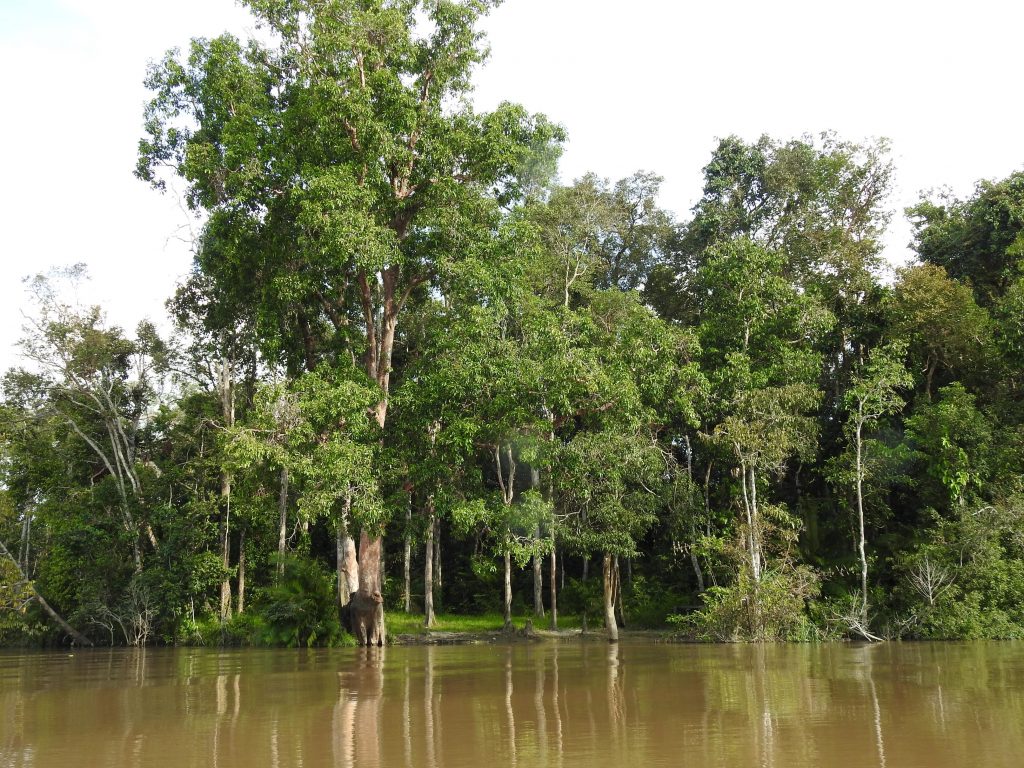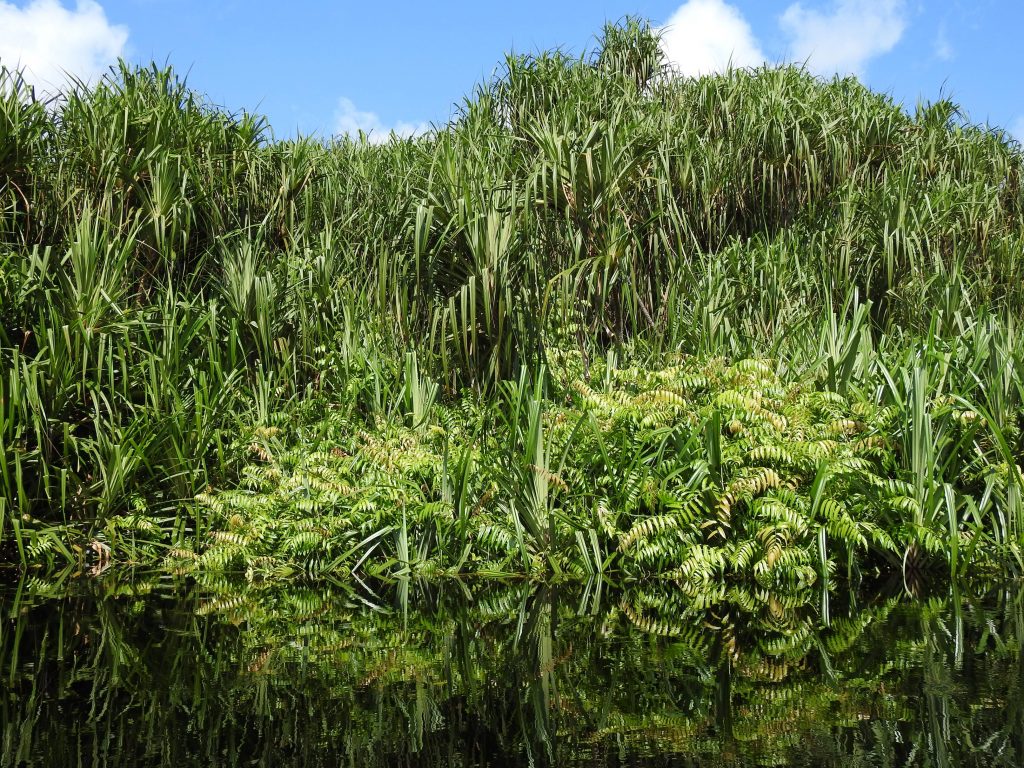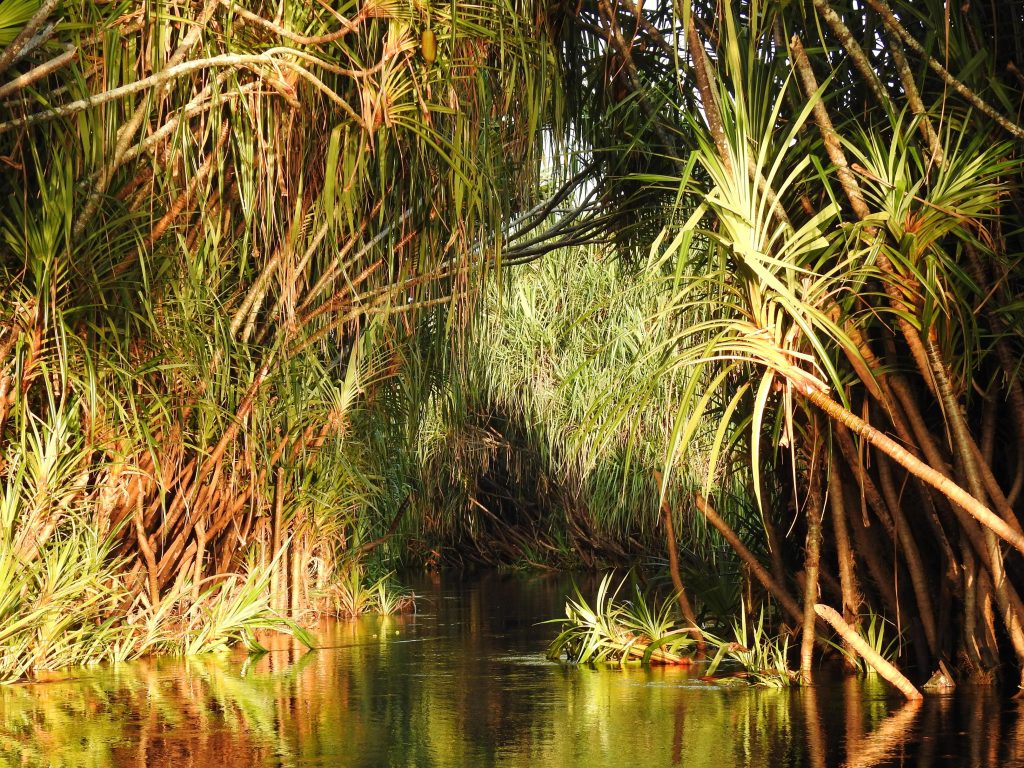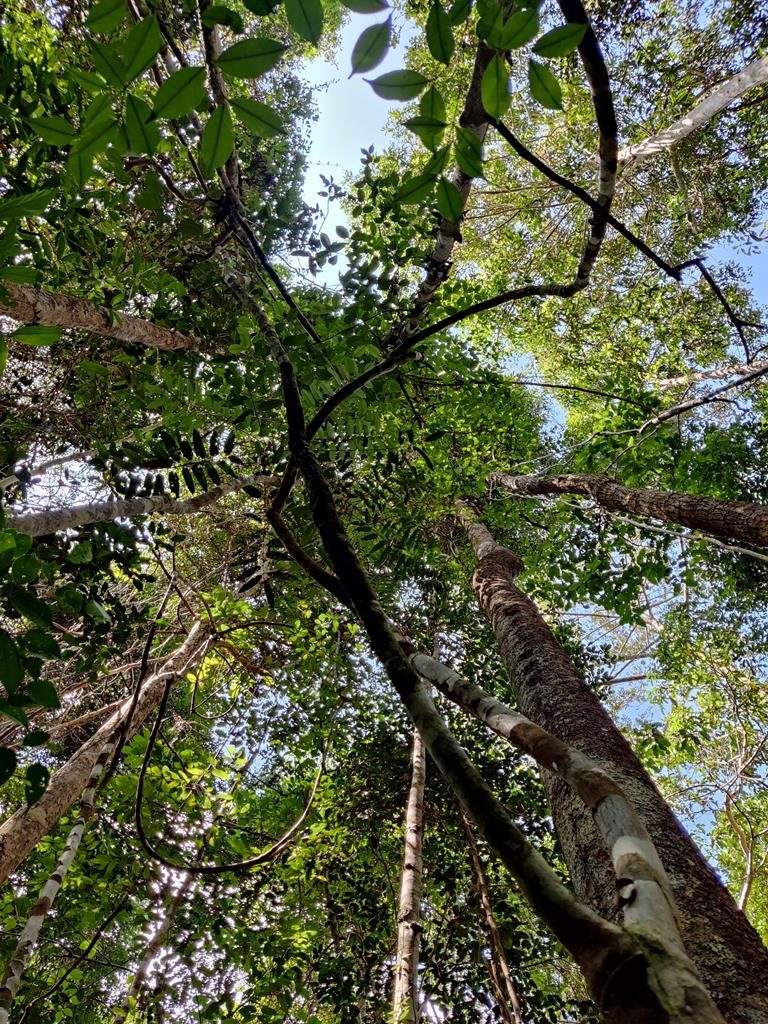When we were planning our trip with Radena, Borneo was not on the list, because it was she who mostly organized it and she had other places in mind, but I had previously added an island (Sumba) I wanted to see with some nice trees you can photograph at sunset, however, we figured that it wouldn’t make much sense to go to the island only to see some trees when we can actually go to Borneo, the Indonesian part of it. She didn’t think about it before so when I offered it she was just as excited as I was. I was, however, also a bit worried, because Indonesia is a Muslim country after all and I didn’t do enough research and wasn’t sure how safe it was but certainly, it didn’t look like a very touristy place and that did not help my sense of safety much.
HOWEVER!
This turned out to be probably the best part for me, yes we could find around ZERO organized trips there so basically we had no plan whatsoever, the trip to see orang utans (two words on purpose, that’s how they spell it in Palangkaraya) in the wild was very expensive, we didn’t plan the time for it but already had flight tickets, so we really had limited time and so we weren’t sure what we’ll be able to see. We just opened Google Maps and figured that there’s only jungle which is what I wanted to see, but HOW? We couldn’t go alone, nor we knew anyone, nor we could find anything online. And we were a group of 3 women, so maybe not very safe to wander around by ourselves. I had gotten us a personal alarm just in case (a bit of a paranoia haha), Ashley, but I’d lost mine during our Rinjani Moutain hike in Lombok earlier on our trip
So here we are, at our hotel, one of the 4 **** hotels in the city of Palangkaraya, the capital of Central Kalimantan. The funny thing is that this was a better and much cheaper hotel compared to Labuan Bajo where we paid a ton of money and my bathroom stunk from the pipes and made my stay a real nightmare, basically, all rooms were like this.
Anyway, Kalimantan is the Indonesian name of Borneo. The Indonesian part is the bigger part of the island and is split into 4 parts – East Kalimantan with the capital city of Samarinda, Central Kalimantan with capital Palangkaraya, West Kalimantan with capital Pontianak and South Kalimantan with capital Banjarbaru. Normally.. or should I say Normal people go there to see Orangutans but i go there to see the jungle and the birds 😀 And i was NOT disappointed!
So we arrived at the hotel and asked at the reception for contacts of a local tour guide we can use to take us around the highlights of the area. And they found us just that! A great Dayaknese gentleman, called Kornelius Agustinus (or Agus, for short) and his driver Dayat, who basically spent the next 3 days with us. Their trips were a bit on the pricy side but we agreed to that because these were our last days and we knew it would be worth it.
Dayaknese people’s history, culture, and traditions
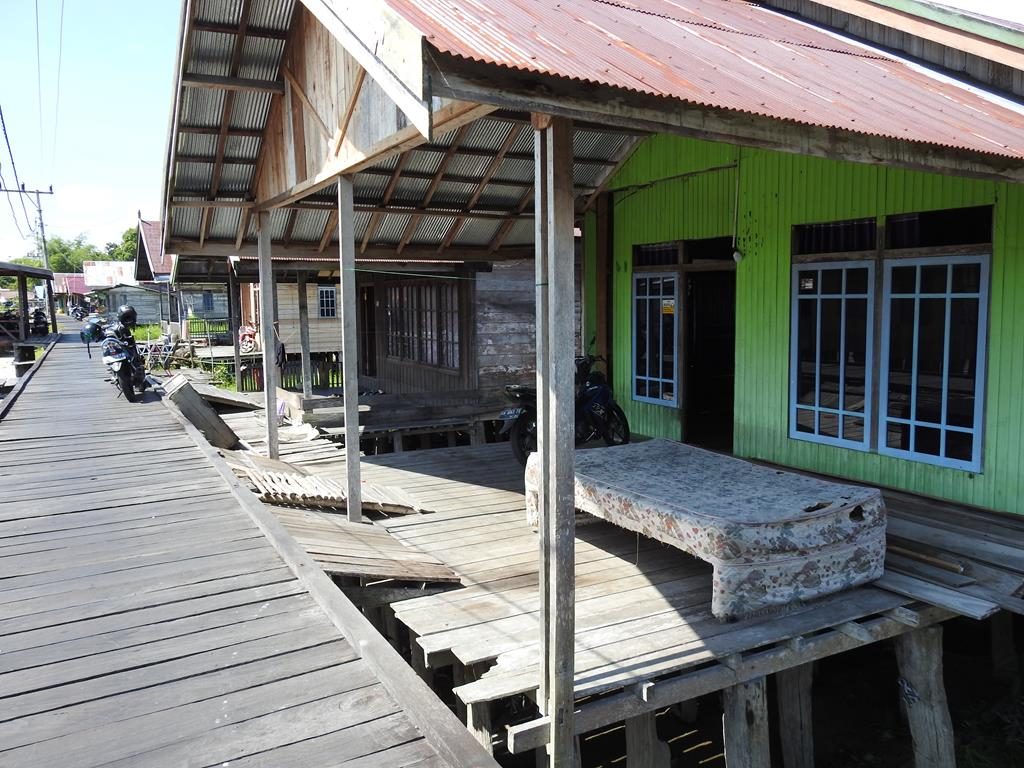 (more photos at the end)
(more photos at the end)
So we started our tour on the first day with a trip to the Dayaknese Museum Balanga.
So first of all, I was surprised (again, lack of research and/or knowledge) that approximately 40% of the people in Borneo were Christians. This made me feel a bit better somehow. They also have many Muslims ofc, but also Hindu and Buddhists and other religions too. So, first thing we hear from Agus is that the people of Borneo came in three generations:
- Generation 1 (3rd to 5th century) – They were already here, their skin colour was red and they were said to jump in the forest like Tarzan and to walk sideways. (i don’t think there’s official proof of that but at least that seems to be the legend spreading among the people)
- Generation 2 (5th till 7th century) consists of several tribes – Dayak Ngaju, Dayak Maynyan, and Dayak Ot Danum. They came originally from South China. Agus’s origin is from the second generation.
- Generation 3 (7th till 14th century) – Malay tribe in Central Borneo and in South Borneo Bandjar tribe
The year 2001 was marked by the Sampit conflict, when an outbreak happened of inter-ethnic violence in Indonesia, began in February 2001 and lasted throughout the year. The conflict started in the town of Sampit, Central Kalimantan, and spread throughout the province, including the capital Palangka Raya. The conflict took place between the indigenous Dayak people and the migrant Madurese people (coming from the Madura island just north of Java).
In Sampit Dayaknese were only 10%, Maduras around 20-30%, Banjar also 30% and the rest is Javanese. So Dayaknese is a minority group in Sampit. So Maduras have lots of power. You cannot work at the port if you are not from Madura.
The conflict was ignited by aggressive acts of violence on the part of the Madurese, who murdered some Dayak people and took control of Sampit, declaring that it is “the second Sampang” ( Sampang was a city in Madura island) basically saying that this is “the second Madura.” For several days, Madurese mobs attacked and killed Dayak people. For three days Madurese won, however on the 4th day, Dayaknese people contacted more people from other areas to come and help them. As a result, hundreds of Madurese were eventually decapitated by the Dayak. (the Sampit conflict info was partially taken from Wikipedia but also enriched with information by our guide)
Due to the conflicts between Madurese and Dayaknese, the latter lived in the so-called Long Houses where several families, sometimes 10, would sleep and live in one long house consisting of only one room. This was to protect themselves from a sudden attack by Madurese people coming to kill them. Although this doesn’t happen anymore, people still live in Long Houses. We did see some houses having a single room, but they were along the river and were smaller. The real houses are somewhere in the depths of the forest, where we couldn’t go this time, unfortunately.
The name Kalimantan comes from “Kali” – river, “mantan” – big- so Big river. Also, mantan means gold and diamonds. Diamonds are mostly mined in South Borneo, while gold is mined in Central Borneo. Following the Indonesian National Revolution, Indonesia became independent from the Dutch colonization on the 17th of Aug 1945. All the islands from Sumatra to Papua joined Indonesia, but local people from Central Borneo didn’t know about that (haha? like how?! 😀 ).. anyway.. they joined Indonesia 15 years after because students studied in Java and they were asked if they want to join Indonesia and the students were like “Why not”, so they agreed 😀 So Kalimantan joined Indonesia on May 20, 1957. In fact, Central Kalimantan didn’t really join Indonesia because of students, that’s likely another myth spreading among the local people. They joined in order to be part of an independent country rather than be under the Dutch, and also to be part of a unity with people from so many regions, languages and traditions of their own. In Indonesia, there are 175 languages. People are proud because they managed to unite all the languages and religions into one country, while Malaysia (by Malay) and Singapore (by Chinese) were split into separate countries because they couldn’t get over their differences in religion and language. So Sukarno united Indonesia.
In Dayaknese culture, before people marry they have other traditions – Hakumbang Auh is like a promise, the man’s family goes to the woman’s family and they give money to her family and request the woman for the wife of their son. But if one of them cuts the relation/promise, has to pay to the other party. What is interesting, is that in Sumatra, it is the other way around – the woman pays for the man. Seems that in Japan is the same. But back to Dayaknese – once the families agree, they prepare a formal agreement, called Maja Misek, where they write down everything about the wedding ceremony from religion to sarong length, to food, etc. And then is the wedding. There are 3 certificates for married couples – from the Ministry of Culture, one Religion-related certificate, and one from the government – generic. If you don’t have a certificate for marriage and go to a cheap hotel with your boyfriend/girlfriend as a tourist (also foreign like us), they will not let you stay in the same room, or sometimes they won’t let you stay in the hotel at all.
The instrument they play in Central Kalimantan is called Kecapi, and another one is Sampe. There were two men playing Sampe at the airport and I fell in love with the music right away! I still cannot stop listening to the videos I recorded. Really amazing, brings in some sort of vibe and my brain connected with Borneo and from now on whenever I think of Borneo, I would hear this music in my mind. I love the way my brain has always made connections between music, places and feelings. ❤️
Here are some videos that Agus sent me on whatsapp:
- KARUNGUT DAYAK KALIMANTAN TENGAH. ANDI PUTIR BUSU.By.BUDI P. (traditional)
- Instrumen Sape’ Dayak I Relaxing Musik sape’ pengantar tidur (relaxing)
- FULL ALBUM SAPE COVER UYAU MORIS (Tanpa Iklan)
- RELAXING MUSIK SAPE BORNEO PENGANTAR TIDUR!!
- Tari Manasai – Kolaborasi Kanwil DJPb dan KPPN lingkup Provinsi Kalimantan Tengah (traditional)
- MERDU !!! Instrument Suling Dayak Bikin Ngantuk (relaxing)
Another tradition Dayaknese had was when a woman gives birth, they keep the placenta outside of the house for one month and they light a fire outside of the house every night. Seeing a fire outside the house means they have a baby. Dayaknese believe that the placenta is another brother/sister of the baby. Dayaknese believe in 5 spirits – of ourselves, of our mother, our father and God. A good shaman can communicate with these spirits.
In the region in Central Kalimantan where the Kaharingan faith prevails, when someone passes away, people perform the Tiwah ritual to guide the spirit of the deceased to Heaven. They exhume and bones of the deceased months or years after their death. They purify the bones and put them in a new, small coffin with new fresh clothes. They sacrifice a cow by beheading it. But in the past times instead of a cow, they beheaded children. They believed that if the parent goes to Heaven, the children must be there too, as slaves of the parent. But they did not do this to their own children but rather steal children from the neighboring village. This is one of the reasons for headhunting in Kalimantan. Fortunately, this is not practiced anymore, but when they sacrifice the cow, but before that they talk to the cow and explain to it that it will help guide the spirit of the dead to Heaven and the cow cries and then doesn’t get crazy while they are in the process of slaughtering it. If the deceased is a man, they sacrifice a bull, if female – a cow. The whole family kills the cow together. Here is a video of the tradition, without the sacrifice, so that’s easier to watch. There’s more to learn about the ritual, if you’re interested, read this article here.
Also, the holy book of the Kaharingan people is called the Panatura holy book. This is their bible basically. In Kalimantan, people offer food for the spirits once a day, while in Bali – three times a day, so people in Kalimantan joke that their spirits are skinny bc they eat only once a day 😀
This was the main part of what Agus told us in the museum about Dayak people’s culture, history and traditions.
Orangutans
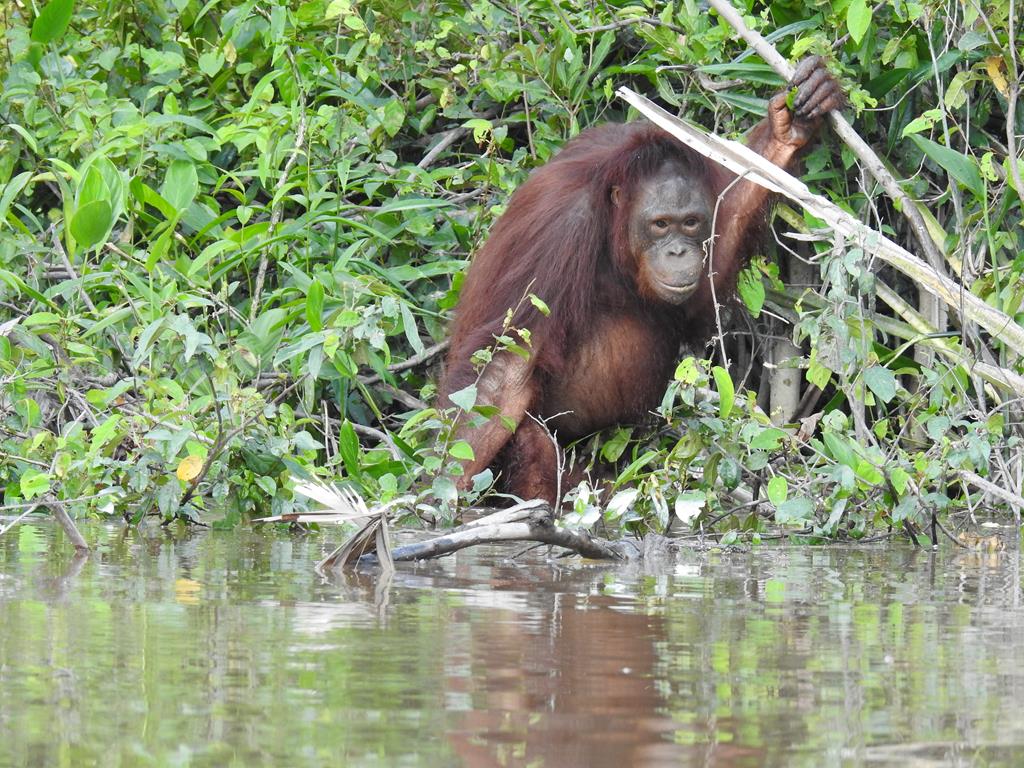
To my surprise when I shot the question of “Is there any chance we can see orangutans here? We only found a few-day trips to the depths of the forest related to that.” and Agus’s answer to that was “Yes”. Soo exciting! He explained that we can go see orangutans in the Jungle School for Orangutans which is basically a sanctuary kind of place where “students” learn how to survive in the wild, forage for food, build nests etc, there is another similar project in East Kalimantan, run by a foreigner Dr. Signe Preuschoft in cooperation with Four Paws (“School of Orangutans”). These schools are basically bringing back to health animals that ended up there for one of the following 3 reasons:
- Someone had killed the mother orangutan years ago and stole her baby to keep it as a pet. But the authorities found out about it and confiscated it
- Deforestation – jungle areas being cleared for the purpose of Palm Oil plantations – unfortunately though, this is a massive problem in Borneo. More about it follows below. So when they cut the forest which is the orangutans’ habitat, they are then sent to this sanctuary.
- Illegal trade of orangutans
So they help the orangutans by bringing them to health, and teaching them important survival skills such as how to forage for food, what is and is not edible, how to build a nest on the tree etc. Once they are ready, they are released in a certain part of the forest which is part of the “school” grounds but is a wild jungle and they leave food for the animals there daily. Once an animal stops coming there for food, it’s considered “graduated” from the school. In reality, this means one of two things – it is either is able now to find food for itself, or an accident happened to it. They say the orangutans are the forest heroes, because they disperse almost 200 seeds every day from their food and thus, effectively planting the forest. They can “plant” up to 1 km radius daily! It is a real disaster that they are going extinct, hopefully, this will not happen, but.. well let’s be realistic, humans have done their “best” to make sure many animals and plant species get extinct and that doesn’t seem to slow down..
Anyway.. so we took a boat and sailed down the river around the areas of the school. We did see two orangutans first, then we saw two more hidden in the trees close to the water and we then saw more jumping between trees and one walking in the shallow waters and looking at us with curiosity 🙂 This was an amazing experience!
We also saw a new for me, BEAUTIFUL, BEAUTIFUL kingfisher, stork-billed kingfisher, such a gorgeous bird. Here’s a photo of it (from the net). Mine is with very bad quality and you can find it below when I talk about our rainforest trip. This is also a HUGE bird, 35cm big, i’ve never imagined it would be so huge and so beautiful

Borneo’s rainforests and the secrets they hide (Sebangau National Park)
The rainforest is a truly magical place in my opinion. Especially as a bird lover, I don’t only appreciate the beauty of the forest itself with all its lushness and beauty, but also all the new and interesting, mystical sounds of birds and beetles I hear. I am in the forest with all my senses and trying to remember every little leaf and giant tree I see, all the colourful fungus on the trees, little mushrooms on a tree bark piece on the forest floor and all of Tarzan’s tree vines 😀 I just need some quiet time with myself to enjoy it completely.
Our jungle trek was preceded by the most amazing boat tour ever – a beautiful ride among palm trees on the river Koran. It was also quite a long ride, maybe 2h or so. We first stopped at the jungle part where we would be walking. We had an option of either 1h or 2h trek. We chose 1h because the mother of Radena couldn’t walk for a long time and also the jungle was quite difficult to walk – no pathways really, you just have to go over tree roots, branches, in between leaves and bushes so it was really, very wild. I totally loved it though. This is exactly what I wanted. In the rainy season, this would’ve been a swampy forest and they showed us a video with other tourists where they have to literally hold on to the vines and jump over swampy areas, JUST LIKE TARZAN 😀 Now i see where the inspiration for the movie/cartoons came from haha 😀
They told us later, that this part of the forest is an area that they tried to convert to palm oil plantations but they failed and so this is a new forest basically. So unfortunately we didn’t get to go really deep into the wild jungle and see the tree roots under which you can stand and feel tiny. But it was still amazing. I started jumping like a crazy kid when I saw the carnivorous plant I really wanted to see in the wild – Nepenthes Ampullaria! A CP with tiny round cups growing mostly on the ground and digesting everything from bugs to dead leaf matter or even poop. In fact, there’s another, critically endangered Nepenthes Lowii, that “evolved” into a toilet haha 😀 Literally.. there’s a tiny mouse-like creature, who licks the sweet juice on the top of the nepenthes cup which is usually the juice that attracts prey to the pitchers of the plant and they then fall inside and drown and the plants normally would release digestive enzymes to consume the bugs, or sometimes frogs, lizards, and even small mice. But not this one, the one that achieved a perfect symbiosis with the Lowii, literally feeds off the nectar of the plant and then as a “thank you” it poops inside the pitchers and that’s how it feeds the plant in turn. Here, a useless fact for you to know 😀 Here’s a video from a Nepenthes nursery where they crossed the Lowii with another, giant variety of Nepenthes and it produced a huuuuge Lowii 😀 Amazing really. For me, at least 🙂
But I really love Ampullaria because it’s tiny and the pitchers are round and cute, I do not generally like Nepenthes, I grow all the other types of amazing Carnivorous Plants, though, ever since 2017. I’ve got a small collection and love taking care of it =)
So when I saw these plants as well as a few more Nepenthes varieties, I was, naturally, really excited. Loved seeing CPs in their natural habitat. Felt the same way last year in Ireland when I saw, totally unexpectedly, another CP type, called Pinguicula, and it was Pinguicula Grandiflora (the plant with purple flowers) which has sticky leaves, and this way it gets the nutrients it needs. I got a tiny plant with 2 flowers and collected the seeds and this year I’ve got many baby plants 😀

So we did the trek and then continued to the “resort” as they called it. That was a tiny, sweet house in the middle of nowhere (if you ask me) where we had lunch. Our boat driver, Yadi, cooked fresh fish for us along with a strange fruit which was a mix between Durian and Jackfruit, they cook it as a vegetable basically, to accompany the rice and meat you normally eat. He also cooked vegetables and this was one of the best lunches we had during our whole stay, even fancy restaurants couldn’t compare to our lunch on the ground of a little house in the middle of the Borneo jungle. THE BEST!

This is the fruit that was later cooked as a “vegetable”. It tasted like fish when cooked but was very sweet when fresh
While we were waiting for the food to be ready, we swam in the black water of the river Koran. The currents were quite strong but we had a ton of fun, except.. I had forgotten to put on swimwear so I had to swim with my sports bra and shorts (Agus didn’t let me go in with underwear haha).
We stayed at this place until we decided to leave, there was no rush and it was great! I went up and down the wooden path to listen to some birds and on the way back we saw that beautiful colourful Stok-billed kingfisher. My picture is really bad and the bird is tiny, but hey, at least I have it in a picture 😀 When it’s zoomed in you can kind of see it’s the same bird from above 😀

We then went back and this concluded our second and, for me, the best day in Borneo. On the next day, we had already checked the main highlights so we went on a boat to a lake, however the lake’s waters were too low so we couldn’t sail any further. We did see the local village, though as well as the equipment they have placed in the water of the river for mining gold. This was the area where they’d mine gold and so this machinery was everywhere in the water.
However, we did not enjoy that trip as much, because of the scorching sun and no single spot of shadow, we barely survived the heat that day, but besides that it was another fun day in Borneo. We also went swimming in another place with black water and our car got stuck in the sand 😀 So instead of swimming, we started off with digging the sand from underneath the car and pushing it while a little Nepenthes plant was sitting right next to us and was laughing at us haahahaah 😀 That was surely an experience we’d remember 😀 Oh, we also ate local ice cream in a Spongebob cone while Agus’s was in a slice of bread 😀 😀 😀 This was ridiculous and so funny 😀 Unfortunately, this was the end of our trip to Borneo and Indonesia in general. We had to leave the following morning. We separated with Agus and Dayat, wished them well, and said goodbye.
Borneo’s Palm Oil Industry
Unfortunately, Borneo supplies approximately 85% of the global demand for Palm Oil and there’s palm oil in almost everything you eat, after seeing that I think I will incorporate as much as possible palm oil-less (that’s not a word.. i know, but well.. now it is) products in my daily life. Please do so too! You can read more about this problem here. So why do local poeple cut down the forest for their plantations when they own land around their cities/villages? Agus told us that there are three instances that give you documents for land ownership – local municipality, (something I forgot) and the government document. So imagine you plant your palm in your own land. It starts working very well, some of your neighbours maybe envies you or whatever and dig a document out of somewhere claiming that part of your land is his. You have your document, he has his document. So this causes lots of disputes between people. So what is the solution? Just go and cut down some jungle area and make your plantation there.. Not sure how this part is regulated but apparently that’s the preferred and seemingly, working way for local people to earn some money. They say that this not only gives them jobs and a way to survive, but also the demand is growing bigger, because this oil can be used as bio-oil to power up vehicles and boats, or so they say.
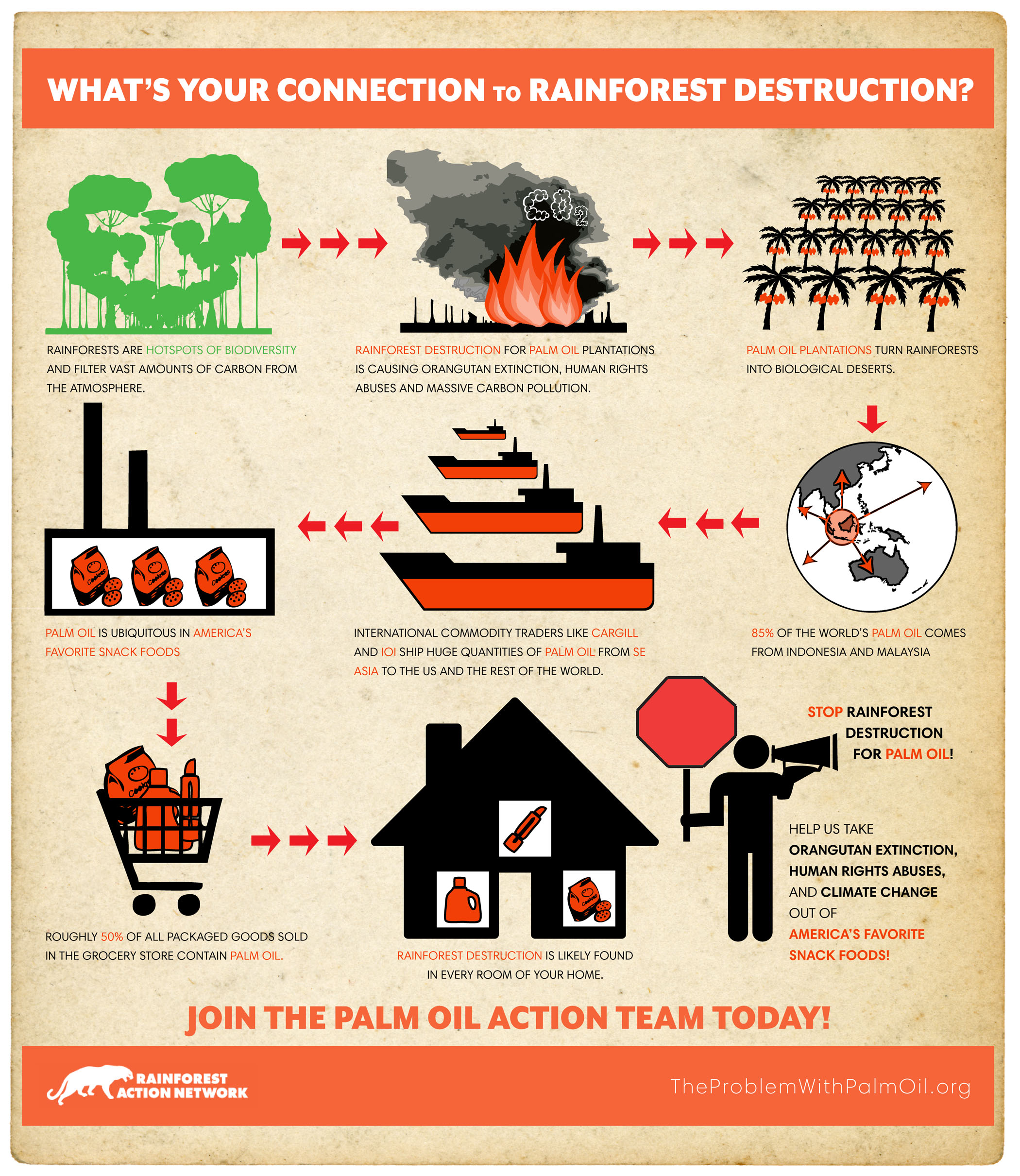
All other weird requests of ours for Agus and Dayat
We really loved the welcoming from our local guides. They were really amazing and did their best to make us feel great and followed all our requests such as “Oh, but I need to stop at some market to buy {insert_any_unnecessary_item_here}” or “I want to stop somewhere to eat Durian” (Gooosh, how can Redena do this, I don’t know 😀 ) or “Do you have a flower/plant market where I can look for a Nepenthes Ampullaria to bring home?” (guilty of that) and they DID have a market, but finding the plant proved quite difficult BUT in the end, it was a success – I found and bought one from a florist and managed to bring it back in one piece, except.. i have a problem now – how to keep it alive, I must spend approx 200 EUR to buy a terrarium for it. So, for now, it lives in a plastic box, poor thing 😀 Until I research and get an aquarium for it. Radena also bought a bunch of plants and we were both very happy with our findings Oh they also let us try a CORN ice cream, this was AMAZING! And local ice cream inside a slice of bread haha 😀 and also mango ice cream and watermelon ice cream. All sooo delicious and really just like their real counterparts.
Following is a soundscape from Borneo, recorded by the owner of the channel. It’s so magical to listen to the sound of the rainforest, i’m sure you’d agree with me on this one 🙂 Imagine that this piece of paradise might be gone in a decade or two due to the palm oil industry.. this is so heartbreaking, but we can all contribute to saving it – look at the ingredients list of the items you buy and don’t buy these things if they have palm oil.. you can start with nutella..

Gallery with more photos




